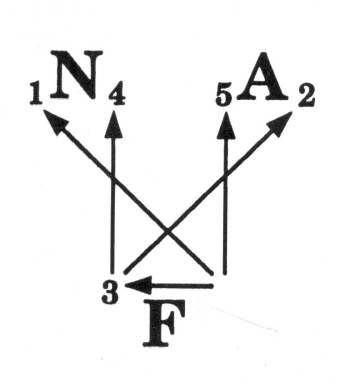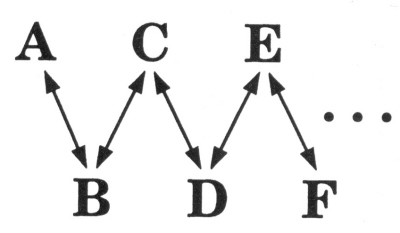There
is one potential collision problem here. It occurs on the first
feedee's second L-R pass because the feeder has to throw an extreme
diagonal
I
consider this a natural feeding extension of Jim's 3-Count, but you
may decide the pattern's name is quite apt before long. The oddity
here is that, because of the added handacross, the feeder makes seven
throws while each feedee is doing six.
One
quick note for the feeder. You're actually passing: R,L; L,R; L,R; R,L.
All of the R,L pairs are extreme crossing passes to the outside hands
of the feedees, while all the L,R pairs are virtually straight passes
(though L- L and R-R) to the middle hands of the feedees. That is, you
do outside-outside, middle-middle, middle-middle, outside-outside, and
you always pass to the feedee on your left first in every pair. Not
too hard - you just have to do a handacross every other pair.
If you have trouble with the handacross while feeding, try it without feeding, with just a few quick throws to get the feel of it. You can start with just one club, in your L hand. Have a partner pass a second club toward your L, and just before the incoming club arrives, hand your club to your R hand, then throw it back to your L as a normal self. That's the basic move. Try it with both hands.
For
a little more feel of the real thing, start with two clubs in the R
and one in the L. Now have someone throw you a L-R exactly as you make
your first R-R pass.
After
your R-R pass, throw a L-L (don't hurry yet) and then quickly hand
your remaining club from R to L, and then throw it back to your R as a
normal self. When it feels good, switch to doing this exercise with
the other hand (start with two in the L). Next use this rhythm you've
learned in the full blown feed - it should be easier now.
Once
you can feed the full Madness, if you're very brave you can try to
spice it up for the feedees, who, after all, are doing a simple Jim's
3-Count. All
Unfortunately, changing the feedees pattern in this random way will change which hand of yours they throw to (unless they correct for each straight throw of yours by next throwing one diagonally). The Random Madness thus changes the rhythm that you've worked hard to learn. So I'm afraid that you may end up paying for the feedees' thrills here. Feel free also to add this random feeding technique (and rhythm destroyer) to the other' feeds described below - good luck!
Martin's
Mildness This
is a variation of Martin's Madness. The only difference is that here
the feeder throws
straights and the feedees
throw diagonals. This is easier for the feeder because
straight passes are generally what people are most accustomed to
throwing. Also, there is less of a collision problem here, although a
slight such risk occurs on the feeder's second pass if the first
feedee's first pass (R-L) is short or inside. The sequence of throws
here is shown in Fig. 6 (which is just like Fig. 4 but with, on the
feeder's line only, every R turned into an L and vice versa, and with
the start shifted by three counts).
You'll notice that the feeder starts by passing R,L to the inside hands twice in a row, then L,R to the outside hands twice in a row. Steve Healy suggested the name for this pattern, which I do find mentally milder than Martin's Madness.
Mild
Madness This
is a two-person variation suggested by Steve Healy in rec.juggling.
Here one person does the feeder's role in Martin's Madness and the
other does the feeder's role in Martin's
To establish a complete understanding of the pattern, do the Wild Mild Madness, which is just the Mild Madness but changing roles (between straight and diagonal passes) after every 12-count cycle (every eight passes). What happens if you switch every three counts?
Extended
Madness If
you have more than three people and want to do Martin's Madness,
you're in luck. It turns out that you can repeatedly add a new juggler
next to a feeder in Martin's Madness in the same way that you can add
to a normal feed (see Fig. 8). In both cases, the fourth person (D in
Fig. 8) is added next to the original feeder (B), causing one of the
feedees (C) to become a feeder. Then a fifth (E) can be added next to
that new feeder (C), and so forth, ad infinitum. Each feeder feeds two
people.
When
Martin's Madness is thus extended, everyone on one side (A, C, E,
The usual Madness and Mildness collision potentials exist. So the straight passers should pass long and a bit outside when passing a L-R to a feeder on the left. I recommend,
in fact, that all the straight passes should be made from outside the
leg, but that is particularly important for all passes (R or L)
going to the person on the left. Meanwhile, the diagonal passers
should try to pass long and a bit outside when passing a R-R to a
feeder on the left. |




